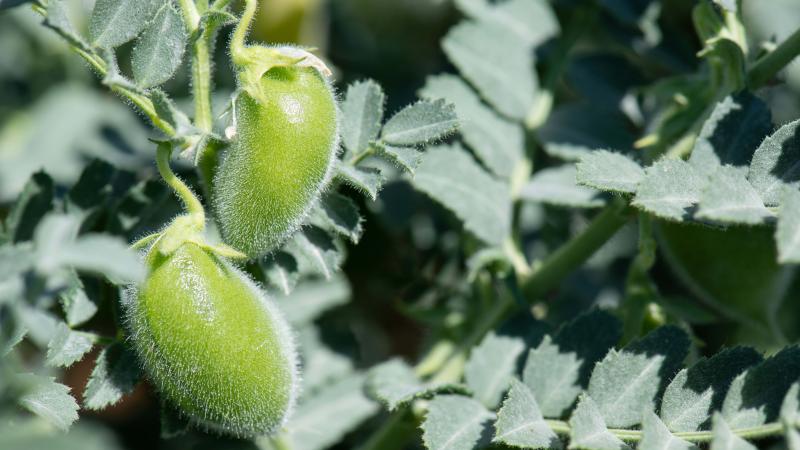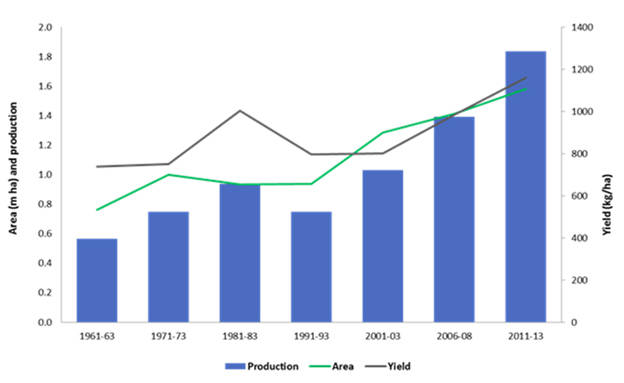Harnessing food legumes for climate-smart agriculture

By Aly Abousabaa
Food legumes offer myriad benefits for sustainable smallholder production systems. When used in crop rotations or intercropping, they can help increase levels of nitrogen in the soil, improving soil fertility, and subsequently crop productivity. They require minimum inputs, lowering the cost of production substantially. They are an excellent source of nutrients and proteins, enhancing food and nutritional security, especially for poor people.
The potential they offer for climate-change adaptation is also substantial. Food legumes can withstand harsh conditions and survive in water-scarce environment. Since they use less than half the non-renewable energy inputs of cereals, they can help cut greenhouse gas emissions. As temperatures rise and water becomes more scarce, food legumes have an important role to play in our quest for climate-resilient, sustainable food systems in the dryland agro-ecologies.
Naturally, food legumes are not perfect. They are highly susceptible to pests and diseases, which limits their productivity and the benefits that farmers can gain from their production. Often, farmers have limited access to new knowledge and technologies. And ineffective seed distribution systems thwart the dissemination of resistant varieties.
Promoting food legume productivity
According to the International Food Policy Research Institute, there has been a four-fold increase in pulse trade since the 1980s. The rising global demand for food legumes presents smallholder farmers with an opportunity to raise their income.
A key constraint of achieving high yield is the unavailability of quality seeds during planting time. The public sector cannot meet the required demand of quality seeds; and the private sector is less interested in this. The establishment of small-scale village seed hubs can resolve this issue. India’s recent success in pulses production is an example of how smart policies and innovative technologies can transform the availability of food legumes. India is expected to close the year with 24 million tons of pulses; just two years ago, they had 18 million tons.
Through a multidisciplinary research-for-development initiative, ICARDA is developing and disseminating improved varieties and production technologies , so that farmers can benefit from the increasing global demand for these climate-smart plants. The results are convincing: more stable yields, healthier soils, and enhanced food and nutritional security.
Our work with the Ethiopian Institute for Agricultural Research has resulted in improved lentil, chickpea, and faba bean in the Ethiopian Highlands. Adapted to local conditions, they have increased yields substantially (Figure 1). A participatory system involving farmers in seed multiplication has also enhanced dissemination. Production has increased three-fold; and pulses are now the third-largest crop export from Ethiopia after coffee and oil seed, representing a $90 million export industry.
Across India, Bangladesh and Nepal, ICARDA has encouraged the cultivation of land left fallow after the rice season as a means to boost lentil production and help reduce import dependence. The approach comprises three types of interventions: the development of early-maturing, high-yielding, and disease-resistant varieties; relay-cropping techniques; and capacity strengthening of farmers, extension workers, and regional scientists.
ICARDA’s work in South Asia also includes developing and disseminating low-toxin and toxin-free grass pea varieties. Grass pea is a versatile crop that can tolerate extreme heat, drought, and is resistant to insect infestations. But farmers were reluctant to adopt it as a cultivation crop because its long-term consumption can be dangerous for human health. Improved cultivars free of toxin are making this hardy pulse a viable option. Combined with high-yielding traits, the improved varieties have increased yields by over 40% over traditional varieties.
Finally, in Egypt, we introduced faba bean varieties resistant to Orobanche (root-parasitic herbs), combined with disease and pest management practices. This has boosted domestic production and reversed years of import dependence. These varieties are part of a nationwide campaign that produced an impressive 200,000 tonnes of faba bean in 2017.
Future research and collaboration
Recent advances in the areas of genomics, bioinformatics, digitization, big data, and crop modelling offer innovative technologies. We should take advantage of them, so that our crops can perform in a 4°C-warmer region. These technologies need to be energy-efficient to reduce the overall cost of production to make the crops more profitable to small and marginal farmers.
I was delighted that CGIAR Research Program “Grain Legumes and Dryland Cereals” was launched in February. The program includes two of the most important crops for the region: chickpea and lentil. Unfortunately, crops like faba bean, grasspea, and barley could not find a place in the program. The MENA region, where food legumes are traditionally grown and consumed, have also been left out, even though it is the net importer of crops.
It takes collective efforts to promote smart policies, increase investments in food legumes research, and ensure that science-based solutions reach rural communities. At ICARDA, we believe this can happen through strategic partnerships and capacity building – and that scaling up proven technologies efficiently can unleash the potential of agricultural sectors across the developing world.
Aly Abousabaa is director general of ICARDA.
This article originally appeared in IFPRI Egypt's Arab Food and Nutrition Security Blog.

